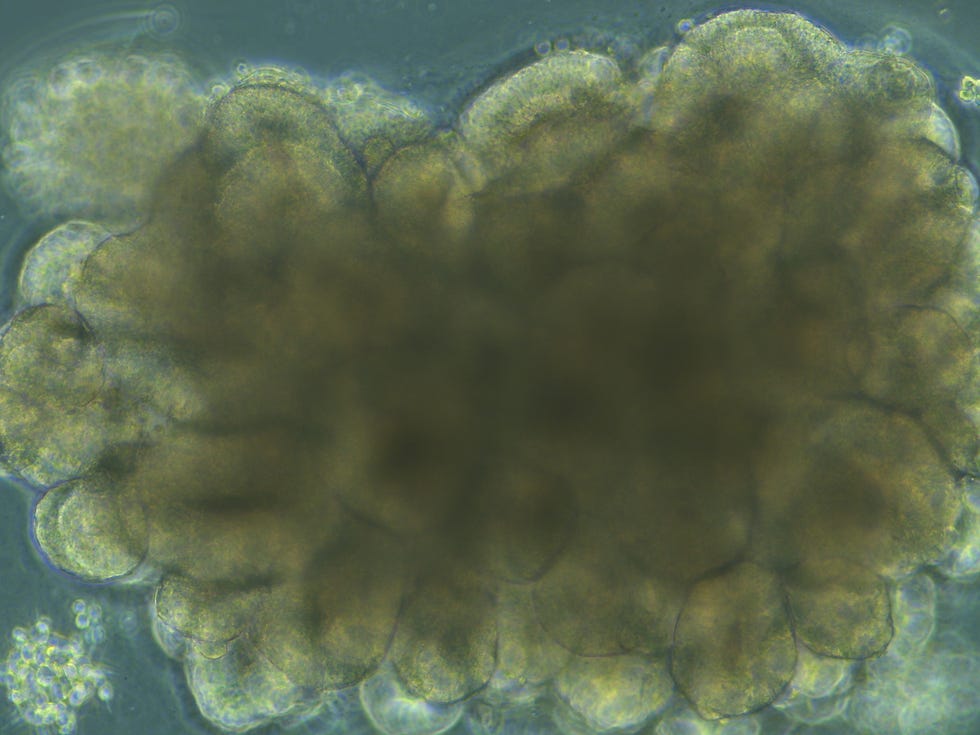Here’s what you’ll learn when you read this story:
- Since 2013, scientists have been growing miniature brains in the lab to aid in the study of neurodevelopmental disorders among other things.
- It’s unclear if these “brain organoids” currently are—or will ever be—conscious.
- Scientists can keep brain organoids alive indefinitely for research purposes, but they usually “kill” the gooey blobs after three years.
Since 2013, when the first “mini brain” was grown inside a test tube in order to study a genetic disorder, scientists have been mad at work. In August 2021, researchers at the University Hospital Düsseldorf took these gooey human-brain blobs—known as “cerebral organoids” or “brain organoids” in neuroscience parlance–and coaxed them into forming early versions of eyes.
Now, an ambitious Microsoft-funded project at the University of California, San Diego (UCSD), is studying the neural activity in hundreds of these sesame seed-sized brains grown inside Petri dishes with the aim of understanding human brain development and evolution as well as helping those suffering from neurological conditions.
“Yet, consciousness in the brain organoid will likely be a consequence of this process,” says Alysson Muotri, Ph.D., a professor in the Departments of Pediatrics and Cellular and Molecular Medicine at UCSD who spearheads the project. That leap to consciousness isn’t happening yet, he says, but it eventually will as science progresses.
Dystopian though it may sound, no one can guarantee with certainty that these miniature brains won’t morph into conscious beings at some point in the near or distant future—and that opens an ethical can of worms. Yet by growing these organoids, Muotri thinks we can unravel great mysteries in biomedical research from how the brain reacts to conditions in outer space to how Neanderthal brains evolved differently than our own hundreds of thousands of years ago.
Brain organoids start off as single stem cells grown in nutrient-filled solutions. Over time, they undergo various differentiation processes until they develop into tiny brains. Don’t be fooled by appearances though. Petri-dish brains may be minuscule—no more than a few millimeters long with only 2.5 million neurons, while the average human brain is about 16 to 17 centimeters long and contains a whopping 100 billion neurons—but this is what your own brain more or less looked like when you were a fetus, says Muotri.
Still, there is a catch. Unlike a brain inhabiting a body, which goes on an explosive developmental trajectory, the Petri-dish brain’s development is stunted after 40 weeks (or nine months) in vitro. Muotri speculates this happens because the organoid lacks the stimuli input and output of a newborn, who will open their eyes and receive visual stimulation from Day 1.
“We are working on giving the organoid a set of functioning eyes,” says Muotri. In the meantime, he can keep the tiny brains “alive” for as long as he likes, granted he or his students feed them properly—with amino acids, lipids, and salt. They usually “kill” them at around three years, though.
But could brain organoids be consciously aware of their own pain or death?
A standard definition of consciousness is the ability to be aware of and responsive to your surroundings. The interpretation is almost too simplistic for a concept that humanity’s best and brightest have been brooding over for millennia.
“We’re still trying to figure out what consciousness is in a well-developed human way, but I think most scientists are aware that what they have [created] so far is really far away from what we might call consciousness,” says Laura Cabrera, Ph.D., an associate professor of engineering science and mechanics as well as philosophy at the Center for Neural Engineering at Penn State University.
This does not mean that brain organoids are doomed to an infinitely lesser existence, though. There is certainly the possibility that at some point in time these organoids might start developing some form of consciousness, the ability to start perceiving pain included. “Then you will be doing something very unethical to an entity that feels pain and is conscious of what you’re doing,” says Cabrera. “Are we really sure we know when we have crossed the line?”
In April 2021, the U.S. National Academies of Sciences, Engineering, and Medicine published a report outlining, among other issues, the potential legal and ethical ramifications revolving around brain organoids, transplants, and human-animal chimeras. The report also raised positive ethical points for these biological materials, as they could relieve human suffering and disease through the treatments they help develop and could spare the lives of thousands of animals currently being sacrificed for human research.
That said, the report also raised concerns about whether the experiments “encroach on divine roles.” According to many religious beliefs, the brain organoid experiments allow us to “play God.” On an individual basis, there is also the potential ethical risk of donors not consenting to the use of their unique genetic material for research.
Further, the report concluded that though mini brains are currently insubstantial in size, complexity, and maturity, as these increase, no one can guarantee that they will not develop some sort of human-type awareness. It is morally imperative that the scientific community keep a close eye on the evolution of brain organoids, the study said. “We don’t know if we have crossed the line, because we don’t know how to test something like this,” says Muotri. A brain organoid cannot tell you if it is conscious or not.
In fact, a 2019 study in which Muotri participated found that organoids produce brain waves similar to those of premature human babies. And when researchers treat these mini brains with anesthetics, the brain waves “go silent,” which is exactly what happens to the human brain under anesthesia. “That’s strong evidence that they do have some kind of primitive consciousness,” says Muotri, who is quick to add that his lab is working with a group of ethicists to help prevent that line from being crossed.
James Giordano, Ph.D., chief of the Neuroethics Studies Program at Georgetown University, also thinks that consciousness is too subjective a concept for academia to confidently assign it—or not—to organoids. Like Cabrera and Muotri, he believes it is possible that these relatively simple neurological structures might achieve some degree of awareness of their existence once they blossom into more sophisticated neurological networks, both in terms of structure and function.
Giordano underscores how multiple-component networks can proliferate quite fast within a brain organoid and start “communicating” with each other. Visualize a cell network in which myriads of people call or message each other to get the picture. Now, what was once a baby brain is a highly sophisticated system that may have established some sense of inside versus outside, says Giordano.
In March 2021, scientists at Tufts University, the University of Vermont, and the New Jersey Institute of Technology announced they had shaped tissue sourced from the stem cells of 24-hour-old frog embryos into the world’s first living robot, the xenobot. As programmable organisms, they represent a whole new class of artifact. “We can be relatively sure xenobots are currently not functioning at a level that would allow the necessary complexity for consciousness,” says Giordano. “Currently” is the key word here. The more these hybrids—which were designed in part to clean up microplastics or digest toxic materials in the ocean—evolve, either directly or through interacting with a living system, the greater the possibility for them to develop some form of protoconsciousness, says Giordano.
Protoconsciousness is a very primitive state of consciousness that mainly includes perception and emotion, but not more sophisticated features like self-reflective awareness and abstract thinking. But what could really happen if xenobots exhibited some sort of self-awareness, coupled with what is universal among living organisms—survival instinct?
“Well, then xenobots might resist coming back to the sea surface, because they were meant to be deep in the ocean and might consider the act of resurfacing a potential threat to their survival,” says Giordano. In that case, our oceans could be glutted with rip-roaring cybernetic frogs, Jurassic-Park style. “This will create a kind of Halloween-type scenario. You know… Frankenstein,” Cabrera jokes.
We may want to prevent even the possibility of creating living science experiments like brain organoids and xenobots that could be experiencing consciousness or pain or distress while we tamper with them. If you have a bunch of organoids you no longer need after the experiment is done, do you kill them or let them remain in liquid captivity for years? What’s ethically appropriate?
We’re creating new life because we’re driven by nobility and vision, but things could get slightly out of hand.
Stav Dimitropoulos’s science writing has appeared online or in print for the BBC, Discover, Scientific American, Nature, Science, Runner’s World, The Daily Beast and others. Stav disrupted an athletic and academic career to become a journalist and get to know the world.







